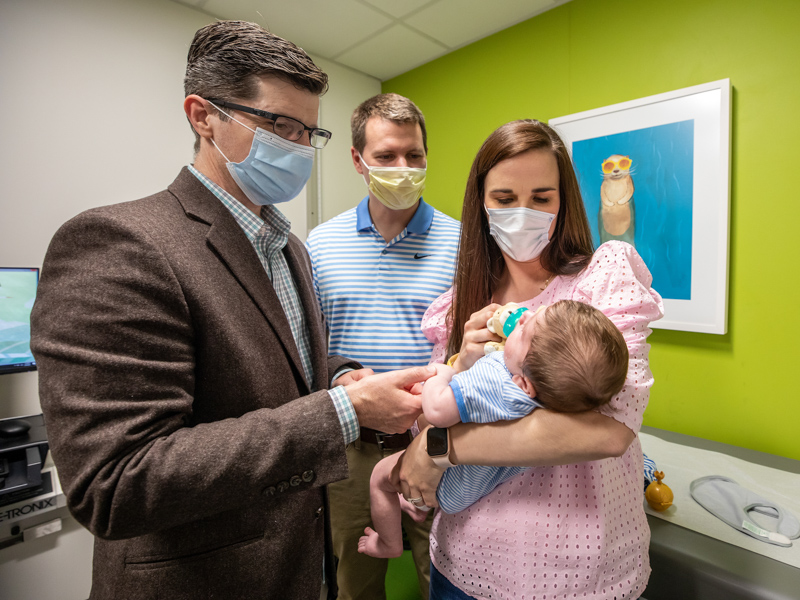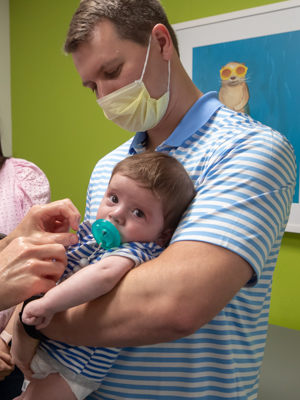For ‘heart babies,’ care from Children’s of Mississippi begins in the womb

Stephen and Rachel Sims found out early on that something was wrong with their third child’s tiny heart.
Barely 19 weeks into her pregnancy with son Bishop, Rachel had what was supposed to be a routine ultrasound with her maternal-fetal medicine specialist in Hattiesburg. The doctor “noticed something wasn’t quite right with Bishop’s heart,” remembered Rachel, a pharmacist at the University of Southern Mississippi.
They were quickly referred to Dr. Scott Simpson, University of Mississippi Medical Center associate professor of pediatric cardiology and a fetal cardiologist, who also sees patients at the Children’s of Mississippi clinic in Hattiesburg. Children’s of Mississippi is the umbrella over all UMMC pediatric care.
Little Bishop’s diagnosis: hypoplastic left heart syndrome, which occurs when the left side of the heart fails to develop correctly. That means the left side of the heart can't effectively pump blood to the body, so the right side of the heart must pump blood both to the lungs and to the rest of the body.
“It was nerve-racking ... to be told that he has a heart condition,” said Stephen, an engineer with Cooperative Entergy in Hattiesburg.
Left untreated, it’s usually fatal. But in Bishop’s case, UMMC specialists are with him every step of the way.

He’s had two of a succession of three surgeries needed to repair and manage his heart condition. The first, called the Norwood procedure, creates a communication between the left and right sides of the heart, enlarges the tiny native aorta while also connecting it to the pulmonary artery, and finally makes a connection between the right ventricle pump and the lungs so that the right ventricle pumps blood both to the body and to the lungs.
That complicated surgery came just six days after Bishop was whisked to the pediatric intensive care unit at Children’s of Mississippi following his Dec. 22, 2021 birth at UMMC’s Wiser Hospital.
Next came the Glenn procedure, which follows the Norwood procedure at about 4 to 6 months of age, removing a shunt placed during the Norwood and redirecting blood flow from the upper body to the lungs.
The third, known as the Fontan, follows when the child is between 2 ½ and 4 years old. It redirects blood flow from the lower body to the lungs.
About one in every 100 babies born has some form of congenital heart defect. Of those, less than 5 percent are born with hypoplastic left heart syndrome.
Dr. Phillip Burch, UMMC division chief of pediatric cardiothoracic surgery, performed Bishop’s first two surgeries. Burch is a leader with The Heart Center at Children’s of Mississippi. Rachel’s care team also included Dr. Rachael Morris, a maternal-fetal specialist and associate professor of obstetrics and gynecology; Dr. Michelle Owens, a maternal-fetal specialist and medical director of the Department of Obstetrics and Gynecology; and Dr. James Bofill, a maternal-fetal specialist and professor of obstetrics and gynecology.
Little Bishop’s multidisciplinary care team at The Heart Center was activated with his visit to Simpson. Simpson and several other fetal cardiologists at Children’s of Mississippi have specialized training in fetal imaging and echocardiography, an ultrasound on the heart that was used to diagnose Bishop.
“We were pretty suspicious that it would be a significant problem, and that it would require a lot of effort and discussion,” Simpson said. “When we met his family early on, we discussed my concerns.”
Burch met Bishop’s parents in The Heart Center’s fetal clinic when Rachel was about 32 weeks pregnant. “We knew that Bishop had a variant of hypoplastic left heart syndrome, and that he’d have to go down a route of a series of three surgeries,” Burch said.
“We’d heard really good things about Dr. Burch,” Stephen said. “We walked away confident that he knows what he’s doing.”
“I followed Bishop through the rest of the pregnancy and counseled them on what to expect, and what it would look like,” Simpson said. That included planning for Bishop to be born not in Hattiesburg, but at UMMC in Jackson, where his heart team would be waiting for him.
Bishop’s Norwood surgery lasted almost six hours. “Bishop came back with his chest open, and they let the swelling go down and then closed it, right there in his PICU room,” Stephen said.
“We routinely bring the OR team to the PICU. Our critical care doctors in the PICU provide anesthesia, and we close their chest,” usually two or three days after surgery, Burch said.
Bishop was discharged a little less than two weeks after his Norwood. “That’s a very short turnaround for a surgery like that,” Burch said. “He had an uncomplicated stay.”
Bishop was then seen weekly and enrolled in The Heart Center’s interstage home monitoring program, which closely monitors children between their Norwood and Glenn procedures. “We tracked all of the data – his weight, food intake, and oxygen levels two times a day,” Rachel said.
The data went into Bishop’s MyChart electronic medical record, where it was accessed and analyzed by his care team. “We also had a hotline that we could call 24-7. It’s a lifeline. Sometimes, they talked us off the ledge,” Stephen said.
“They are dedicated to getting you from one surgery to the next,” Rachel said.
Six days after Bishop turned four months old, Burch performed the Glenn procedure.
Bishop’s parents appreciate Burch for his attention to detail. “He takes longer because he’s so meticulous,” Stephen said. “His results are fantastic because he does take that long. He knows what he’s doing, and he’s doing it right.”
Bishop will see Simpson every few months for the rest of his childhood. “It’s important that they have a capable heart center and clinicians that they can rely on,” Burch said. “You need people who don’t just have an interest and general understanding of heart disease, but who have additional expertise such as cardiac imaging and electrophysiology.”
“I always tell our families that with a significant diagnosis, it’s not just me taking care of the child. It’s the whole Heart Center,” Simpson said. “The family meets with the surgeons, the cardiologists, the neonatal intensive care unit specialists, geneticists. It’s a whole team approach to supporting the baby, and giving them and their family all that we can.”
Bishop’s fan club includes big sister Sally, 7, who loves to hold him, and 5-year-old brother Graham. “Obviously, it’s been tough on them, but we have lots of family to keep them going,” Stephen said. “They love their brother. They miss him when he’s gone, just like they miss us.”
“People go all over the world for these surgeries,” Rachel said. “We would not have done anything differently, or gone anywhere different for this. We are super fortunate to have Children’s just an hour and a half away from us.”
“This family is amazing,” Simpson said. “They are heart warriors, because they go through such challenging situations that most people aren’t faced with. They do the heavy lifting – giving medications, going to doctors’ visits, and so much more between the clinic visits. They can’t get enough credit, in my mind, for doing what it takes to keep Bishop well.
“They’ve been complete rock stars.”
“Here we are, with a happy baby. We hope we have years and years to go. We’re thankful for the time we have,” Stephen said. “We’ve really loved our care here.”


